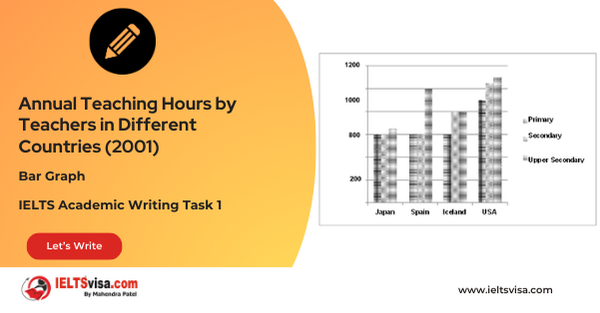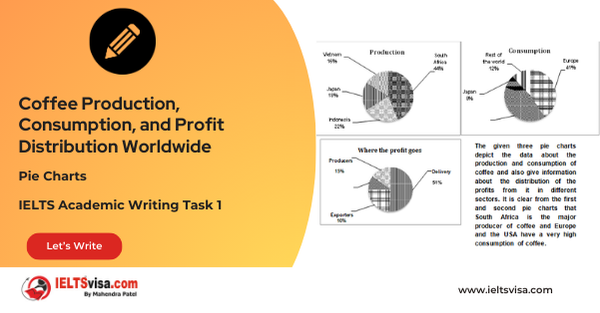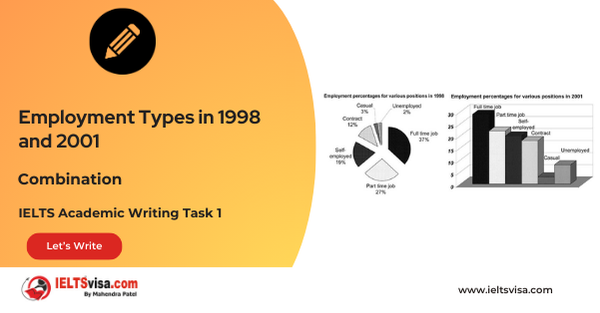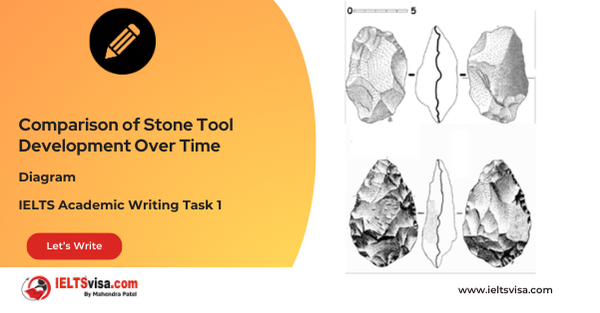The percentage of adults according to age and gender who do not do any physical activity in Australia
IELTS Academic Writing Task 1 - Bar Graph
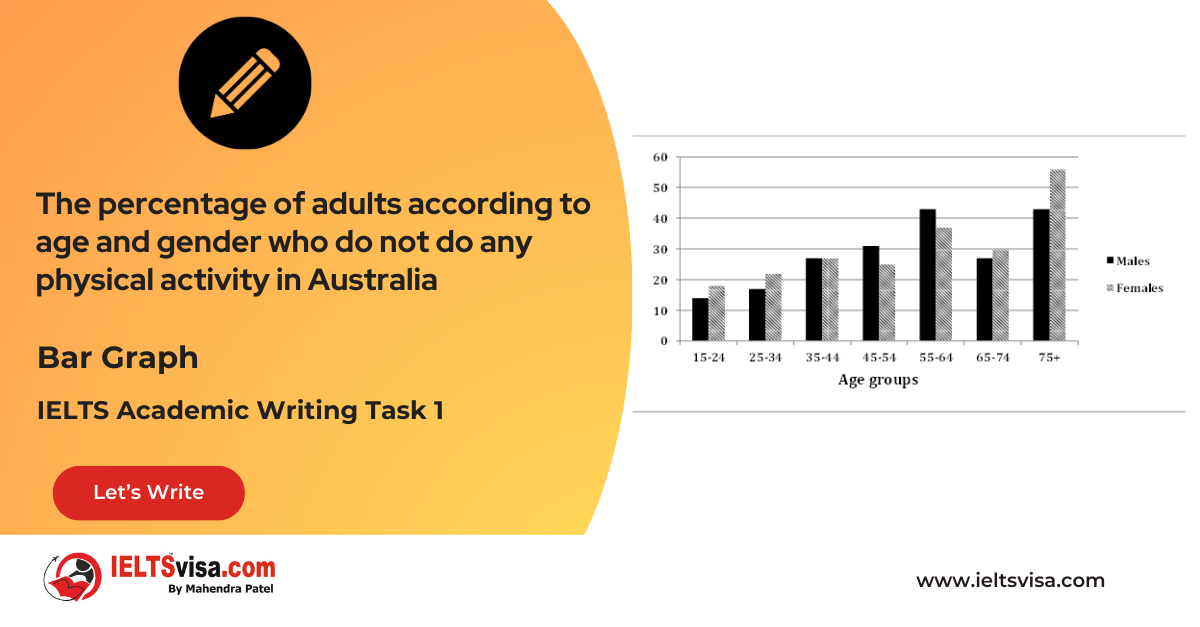
IELTS Writing Task 1 Question
The graph below shows the percentage of adults according to age and gender who do not do any physical activity in Australia. Summarise the information by selecting and reporting the main features and make comparisons where relevant
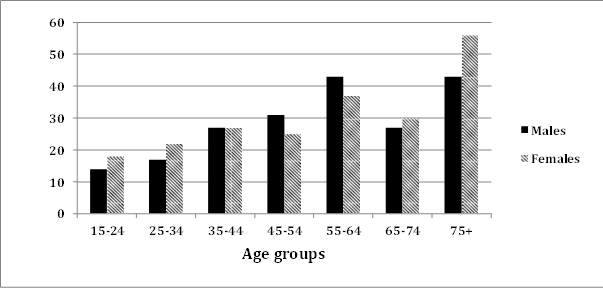
Key Points for the Report
1. Graph Type: Column Graph
2. Title: Percentage of Adults by Age and Gender Not Engaging in Physical Activity in Australia
3. Units of Measurement: Percentage of adults
4. Who: Adults of seven different age groups by gender
5. When/Where: Australia
6. Topic: Comparison of physical activity levels among different age groups and genders
Main Features and Trends
Current Statistics :
1. Age Group 15-24: The most active, with about 14% of men and 17% of women not engaging in physical activity.
2. Age Group 25-34: A slight increase in inactivity is noted compared to the younger group.
3. Ageing Effect: The percentage of sedentary individuals generally rises with age, with an exception for the 65-74 age group, where inactivity drops below the 55-64 age group.
5. Age Group 75+: This group has the highest percentage of both men and women
Sample Answer
The column graph illustrates the percentage of adults in Australia who do not participate in any physical activity, categorized by age and gender.
Overall, it is evident that, with the exception of the 45 to 64 age group, women tend to be more sedentary than men across most age categories.
In the 15-24 age group, physical activity levels are the highest, with only about 14% of men and 17% of women reporting inactivity. The trend of increasing sedentary lifestyles continues in the 25-34 age group, where a slightly higher percentage of both genders lead a less active life.
As individuals age, the percentage of those who do not engage in physical activities typically rises. However, a surprising drop occurs in the 65-74 age group, where inactivity rates for both genders are lower than in the 55-64 age group. Conversely, the 75+ age group sees the highest inactivity percentages among men and women.
Another way to write “Overall.”
“Overall, the data indicates that as people age, the likelihood of leading a sedentary lifestyle increases, with the exception of the 65-74 age group. Additionally, women are generally more inactive than men in most age categories.”
Top 28 Vocabularies
| Vocabulary (type) | Type | Meaning | Synonyms | Examples |
| Sedentary | Adjective | Characterized by much sitting and little physical activity | Inactive, idle, stationery | “More females than males lead sedentary lives in many age groups.” |
| Percentage | Noun | A portion or share of a whole expressed as a fraction of 100 | Proportion, fraction, part | “The graph shows the percentage of adults not engaging in physical activity.” |
| Exception | Noun | A case that does not follow a rule or pattern | Anomaly, irregularity, deviation | “The 65-74 age group is an exception to the trend of increasing inactivity.” |
| Engaging | Verb | Participating or involving oneself in an activity | Involving, participating, taking part | “Adults engaging in physical activity decreases with age.” |
| Inactivity | Noun | The state of not being active or not engaging in physical activity | Idleness, inactivity, lethargy | “The percentage of inactivity rises as age increases.” |
| Illustrates | Verb | To explain or clarify something using visuals or examples | Demonstrates, depicts, shows | “The column graph illustrates inactivity levels by age and gender.” |
| Trend | Noun | A general direction or pattern of change | Pattern, tendency, movement | “The trend of increased inactivity continues in older age groups.” |
| Surprising | Adjective | Unexpected or not anticipated | Unexpected, astonishing, startling | “A surprising drop in inactivity occurs in the 65-74 age group.” |
| Inactivity | Noun | The state of being inactive or not engaging in physical activity | Idleness, passivity, lethargy | “Inactivity rates increase with age.” |
| Drop | Noun/Verb | A decrease or decline in quantity or level | Decline, reduction, fall | “There was a drop in inactivity in the 65-74 age group.” |
| Report | Verb | To give a spoken or written account of something | State, announce, describe | “The study reports that 17% of women in the 15-24 age group are inactive.” |
| Category | Noun | A group or class of things with similar characteristics | Class, type, group | “The data is categorized by age and gender.” |
| Gender | Noun | The social or cultural differences between men and women | Sex, masculinity/femininity | “Women generally show higher inactivity rates than men.” |
| Likelihood | Noun | The chance or probability of something happening | Probability, chance, odds | “The likelihood of inactivity increases with age.” |
| Engage | Verb | To participate in or become involved in an activity | Participate, take part, involve | “Adults are less likely to engage in physical activities as they age.” |
| Percent | Noun | A fraction or portion of a whole expressed as a percentage | Proportion, share, ratio | “The percentage of inactive people rises in older age groups.” |
| Comparison | Noun | The act of analyzing two or more things to identify similarities or differences | Contrast, analysis, evaluation | “A comparison between genders shows that women tend to be more sedentary.” |
| Inactivity Rate | Noun | The percentage of individuals not engaging in physical activity | Inactive percentage, sedentary rate | “The inactivity rate increases as age rises.” |
| Decline | Noun/Verb | A decrease or reduction in quantity, quality, or strength | Decrease, fall, reduction | “There is a decline in physical activity after the 25-34 age group.” |
| Consistently | Adverb | In a steady or regular manner | Regularly, uniformly, continually | “Inactivity consistently increases with age.” |
| Notable | Adjective | Worthy of attention or remarkable | Significant, important, remarkable | “The drop in inactivity in the 65-74 age group is notable.” |
| Pattern | Noun | A regular and repeated arrangement of elements | Trend, arrangement, sequence | “There is a clear pattern in the rise of inactivity with age.” |
| Group | Noun | A number of people or things considered together | Category, class, set | “The graph shows data for different age groups.” |
| Shift | Noun/Verb | A change or movement from one position, condition, or direction to another | Change, movement, transition | “A shift in inactivity trends can be observed as age increases.” |
| Relatively | Adverb | In comparison to something else, usually in proportion | Comparatively, somewhat, moderately | “Inactivity is relatively higher among older age groups.” |
| Observation | Noun | The act of watching or noticing something carefully | Notice, study, inspection | “The observation of inactivity patterns reveals key insights.” |
| Categorize | Verb | To classify or group according to shared characteristics | Classify, group, arrange | “The data categorizes inactivity by age and gender.” |
| Exponentially | Adverb | At an increasingly rapid rate | Rapidly, dramatically, swiftly | “Inactivity increases exponentially as people age.” |

Our Books
Master IELTS Speaking Part 1
IELTS Writing Task 1 Book
IELTS Writing Task 2 Book
Writing Task 1 Question Types
Practice IELTS Other Modules
IELTS Listening
The IELTS Listening test assesses how well you can understand spoken English in various contexts. It lasts about 30 minutes and is divided into four sections with a total of 40 questions. The listening tasks become increasingly difficult as the test progresses.
IELTS Academic Reading
The IELTS Academic Reading section assesses your ability to understand and interpret a variety of texts in academic settings. It is designed to evaluate a range of reading skills, including skimming for gist, reading for main ideas, reading for detail, understanding inferences, and recognizing a writer's opinions and arguments.
IELTS Speaking
The IELTS Speaking test assesses your ability to communicate in English on everyday topics. It lasts 11-14 minutes and consists of three parts: introduction, cue card, and a discussion based on the cue card topic.
IELTS General Reading
IELTS General Reading tests your ability to understand and interpret various types of texts. Here are some key areas and types of content you can expect to encounter in the reading section, along with tips for effective preparation.
IELTS Academic Writing Task 1
In IELTS Academic Writing Task 1, you are presented with a visual representation of information, such as graphs, charts, tables, or diagrams, and you are required to summarize, compare, or explain the data in your own words.
IELTS General Writing Task 1
In IELTS General Writing Task 1, you are required to write a letter based on a given situation. The letter can be formal, semi-formal, or informal, depending on the prompt. Here’s a breakdown of the key components to include in your letter
IELTS Academic Writing Task 2
In IELTS Academic Writing Task 2, you are required to write an essay in response to a question or topic. Here’s a guide to help you understand the essential elements of this task
IELTS Exam Tips
To succeed in the IELTS exam, practice regularly, familiarize yourself with the test format, improve your vocabulary, develop time management skills, and take mock tests to build confidence.
Grammer for IELTS
Grammar is the foundation of effective communication in English. Understanding tense usage, subject-verb agreement, and sentence structure enhances clarity and coherence in writing and speaking.
Vocabulary for IELTS
Vocabulary plays a crucial role in the IELTS (International English Language Testing System) exam, especially in the Speaking and Writing sections. Here’s an overview of why vocabulary is important and how it impacts your performance
RECENT IELTS SAMPLES QUESTIONS AND ANSWERS
Task 1 – Column graph – Percentage of Young People Enrolled in Universities in 2000 and 2007.
20:00 Start Pause Stop [df_adh_heading title_infix="IELTS Writing Task 1 Question" use_divider="on"...
Task 1 – Bar Graph – Annual Teaching Hours by Teachers in Different Countries (2001)
20:00 Start Pause Stop [df_adh_heading title_infix="IELTS Writing Task 1 Question" use_divider="on"...
Task 1 – Pie Charts – Coffee Production, Consumption, and Profit Distribution Worldwide
20:00 Start Pause Stop [df_adh_heading title_infix="IELTS Writing Task 1 Question" use_divider="on"...
Task 1 – Column graph – Types of Transport Used by Tourists Visiting New Zealand from Five Countries in 2004.
20:00 Start Pause Stop [df_adh_heading title_infix="IELTS Writing Task 1 Question" use_divider="on"...
Task 1 – Bar and Pie Chart Combination – Employment Types in 1998 and 2001
20:00 Start Pause Stop [df_adh_heading title_infix="IELTS Writing Task 1 Question" use_divider="on"...
Task 1 – Diagram – Comparison of Stone Tool Development Over Time
20:00 Start Pause Stop [df_adh_heading title_infix="IELTS Writing Task 1 Question" use_divider="on"...


